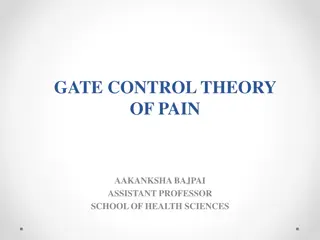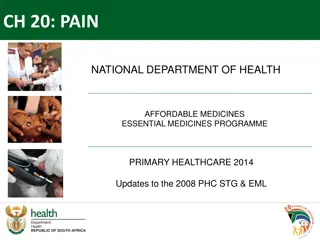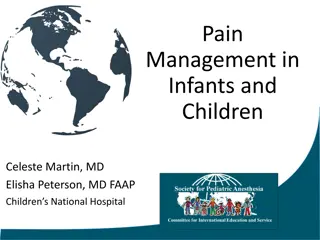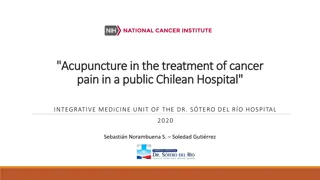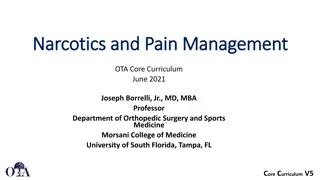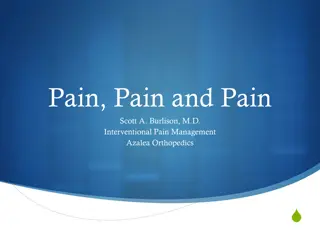Complexity in Cancer Pain Management by Dr. Marie Joseph
Dr. Marie Joseph explores the challenges and successes of managing complex pain in cancer patients. The intricacies of neuropathic pain, diagnostic characteristics, pathophysiology, pharmacology, and typical cancer pain syndromes are discussed. Strategies such as co-analgesic adjuvants, analgesic synergies, and opioid management are highlighted to address opioid-induced hyperalgesia. Various cancer pain syndromes are also identified for targeted treatment approaches.
Download Presentation

Please find below an Image/Link to download the presentation.
The content on the website is provided AS IS for your information and personal use only. It may not be sold, licensed, or shared on other websites without obtaining consent from the author.If you encounter any issues during the download, it is possible that the publisher has removed the file from their server.
You are allowed to download the files provided on this website for personal or commercial use, subject to the condition that they are used lawfully. All files are the property of their respective owners.
The content on the website is provided AS IS for your information and personal use only. It may not be sold, licensed, or shared on other websites without obtaining consent from the author.
E N D
Presentation Transcript
The challenge & success of complex pain management in Cancer BY DR MARIE JOSEPH MBBS FRCP MARIE.JOSEPH1@NHS.NET 2021
The challenge Complexity of pain Predominant neuropathic pain (may not be easily evident) Defies usual pain management Not always sufficiently opioid responsive High doses of mu agonist opioids can worsen pain ( opioid induced hyper-algesia ) Useful & essential co-analgesic adjuvants
Clinical Diagnostic characteristics Vice- like constant ache Intermittent crisis pain episodes Nocturnal pain resulting in insomnia Pathognomonic tactile allodynia in 1/3 Autonomic instability skin changes Painful dreams/escalating pain with anxiety
Patho-physiology of complex pain Nerve injury intra-cellular Ca++ influx Glutamate release (powerful excitatory neuro- transmitter) Glutamate acts on NMDA receptors (N -Methyl D- Aspartate) NMDA receptor activation central hyper-excitation Dampening of brainstem pain inhibitory pathways (Nor-Epinephrine, Serotonin)
Pharmacology of complex pain management Triangular analgesic synergy Opioid Voltage gated Ca++ channel blocker: Gabapentin, Pregabalin Synaptic Nor-Epinephrine enhancer: Nortriptyline, Mirtazapine, Duloxetine * Quadruple synergy-- Benzodiazepine Clonazepam Tapentadol (mu opioid agonist & Nor-Epinephrine re- uptake inhibitor) dual analgesic synergy (in resistant, chronic pain in non-palliative care setting)
Typical cancer pain syndromes Apical lung cancer brachial plexus pain Pancreatic cancer coeliac plexus pain Rectal cancer pre-sacral plexus pain Head & Neck tumours cranial neuropathic pain Mesothelioma intercostal neuropathic pain Spinal metastases radicular neuropathic pain
Opioid induced hyper-algesia (OIH) Caused by inadvertent rapid opioid dose escalation Vicious circle (pain increase with rapid opioid dose increase) High dose mu opioid agonists central hyper- excitation, via Glutamate driven NMDA activity Needs vigilance, recognition -> dose reduction & appropriate therapeutic action Timely stratified co-analgesic adjuvants required Prevented or reduced by analgesic synergy
Clinical case scenario * renal & prostate cancer; pulmonary embolism S1 Spinal metastases Thecal impingement severe gluteal/thigh neuropathic pain RT & Dexamethasone Fentanyl TD 75mcg/hour opioid saturation /OIH Gabapentin 700mg TDS Analgesia achieved with: Oxycodone MR 30mg BD, Gabapentin 700mg TDS, Mirtazapine 30mg nocte (triangular analgesic synergy) Went home & no medication induced adverse effects
Clinical case scenario DRUG TOXICITY VERSUS TUMOUR PROGRESSION
Clinical scenario Breast cancer Brachial plexus infiltration Neuropathic pain, drowsy, lateral nystagmus On Zomorph 10mg BD & Pregabalin 300mg BD! Diagnosed Morphine idiosyncrasy & neurotoxicity due to high dose Pregabalin Analgesic response to Fentanyl TD 12mcg/ hour, Pregabalin 150mg BD, Mirtazapine 30mg nocte Awake; pain much better controlled; went home! Clear example of triangular analgesic synergy
Summary Recognise the complexity of cancer pain Predominant neuropathic pain (may not be evident) Avoid inadvertent, rapid opioid dose escalation Early, step-wise introduction of co-analgesics Vigilance for opioid induced hyper-algesia (OIH) Usefulness of triangular analgesic synergy
Complexity of cancer pain management Thank you. Any Questions?





